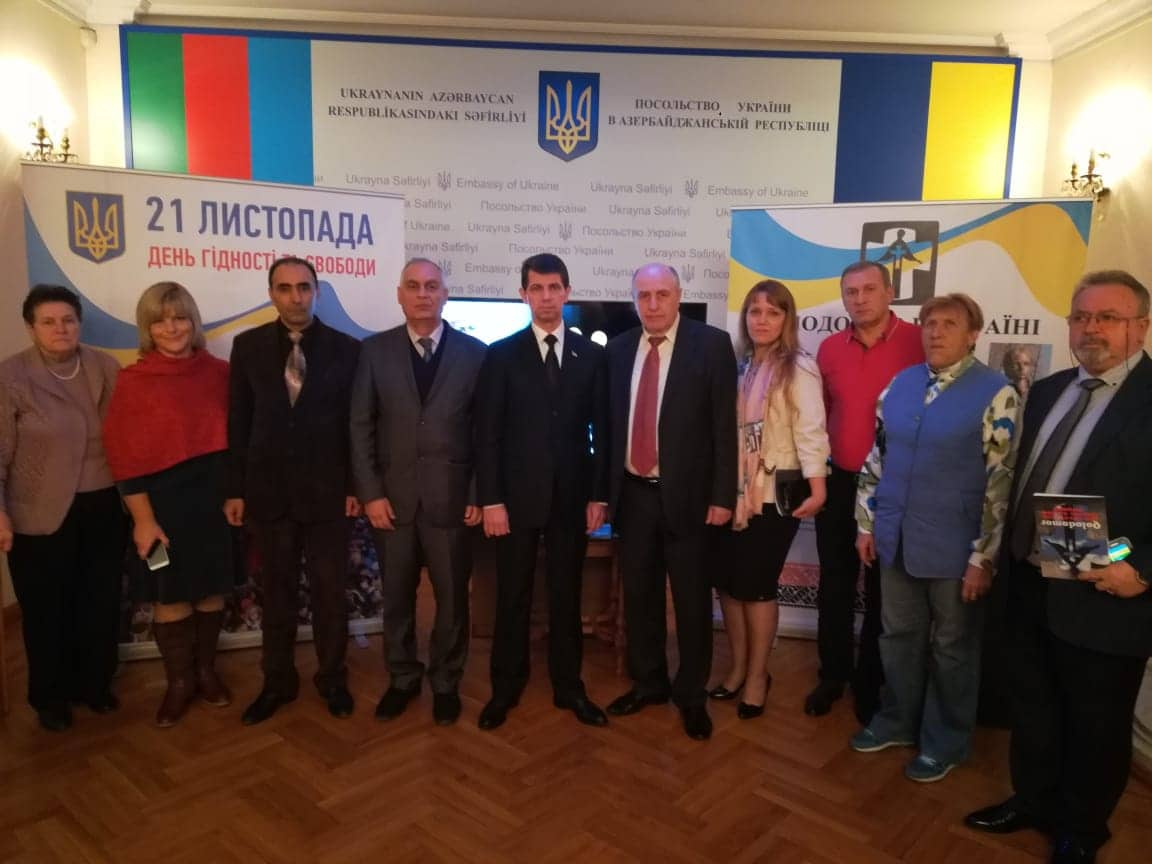The Embassy of Ukraine in the Republic of Azerbaijan held the event timed to the 85th anniversary of Holodomor
On November 15, 2018, in the Embassy of Ukraine in the Republic of Azerbaijan the event devoted to the “85th anniversary of Holodomor of 1932-1933 in Ukraine and the 5th anniversary of the Revolution of Honor” was held, the press service of the Embassy of Ukraine in the Republic of Azerbaijan informs.
The event was attended by representatives of the National Academy of Sciences of Azerbaijan, Baku State University, Baku Slavic University, Azerbaijan Technical University of Social Sciences, political scientists, journalists, representatives of the Ukrainian Congress of Azerbaijan and the I. Franko Ukrainian community in Sumgayit city, as well as specially invited guest from Ukraine, doctor of historical sciences, professor of Taras Shevchenko National University of Kyiv (KNU) V. I.Serhiichuk.
Ambassador of Ukraine to Azerbaijan, Olexander Mishchenko, in his speech drew attention to the millions of Ukrainians who died as a result of the criminal communist regime policy, which led to Holodomor of 1932-1933 in Ukraine.
During the event, the participants honored the memory of the Holodomor victims of 1932-33 in Ukraine with a minute of silence, as well as the heroes who gave their lives to Ukraine and Azerbaijan in the struggle for the territorial integrity of both countries.
In his speech, Professor V. I. Serhiychuk informed the audience that the word “Holodomor” means a mass murder – a famine by which there was no salvation. By this word, Ukrainians call their National catastrophe and genocide of 1932-1933.
The precondition for Holodomor was the policy of collectivization, which caused the acute peasants resistance. Peasant unrest in February-March 1930 covered almost the whole of Ukraine. The checkers in their reports recorded that in Ukraine from February 20 to April 20, 1930, 1,895 villages in 41 districts out of 44, on which the territory was divided, were covered by unrest. In general, during 1930, more than 4,000 mass protests were recorded in Ukraine by intelligence services.
Professor V. I. Serhiichuk noted that the main goal of tHolodomor, organized by the Bolsheviks, was:
- Overcome the counteraction to the policy of collectivization, as hungry people are incapable of any significant resistance. So, in 1930, about 1.2 million peasants took part in mass anti-Soviet demonstrations in Ukraine. During the first seven months of 1932, the Chief Political Department bodies recorded in the Ukrainian SSR more than 900 mass demonstrations, representing over 56% of all anti-government actions in the USSR at that time. During Holodomor, the resistance was practically reduced to zero;
- In 1932, the Stalinist leadership realized that for two years of collectivization, peasant mentality, based on private-ownership traditions, remained as strong as 10 years ago, which did not allow for reliance on the success of the policy of collectivization in the future. Stalin raised the issue sharply: solving all the problems simultaneously – overcoming the resistance of the peasants, intellectuals and national communists in power, to persuade the disobedient and to turn those left to the “Soviet” people who would work for free at the collective farm. It was possible to do this only in one way – massively exterminate the disobedient. Ukraine became a laboratory where terrible experiments were carried out over a large multimillion nation.
Professor V. I. Serhiichuk also informed the participants of the horrible stats according to which HOLODOMOR TOOK: at least 7 million lives.
- In the spring of 1933, in Ukraine died: 25,000 people every day; hourly – 1,000 people; every minute – 17 people.
- In September 1933 almost half of the students did not attend school desks.
For today, these data are not final because the Holodomor scholars justify it only to the archival data of Ukraine.
During the Soviet era, they tried to destroy a lot of information, but now Moscow refuses to open its archives regarding the criminal acts of the communist power of the USSR in Ukraine.
Given the above, historians believe that the objective number of victims was much higher and, after analyzing all unexplored documents today, the total number of victims will be much more than 7 million people, as reported in 1933 by German diplomats based on conversations with senior officials of the GPU.
This data is evidence of a crime that was organized against the Ukrainian people, and Ukraine has collected all evidence of genocide.
In his speech, the candidate of historical sciences, associate professor, dean of the historical faculty of BDU – Mr. Azad Rzayev noted that the consequences of the criminal acts of the communist regime had a significant impact on virtually all regions of the former Soviet Union. Holodomor in Ukraine in this context is of particular importance, as it has led to extraordinary losses among the peaceful population of Ukraine.
